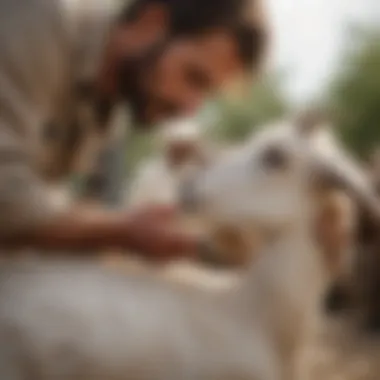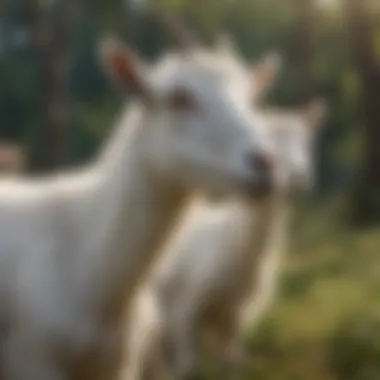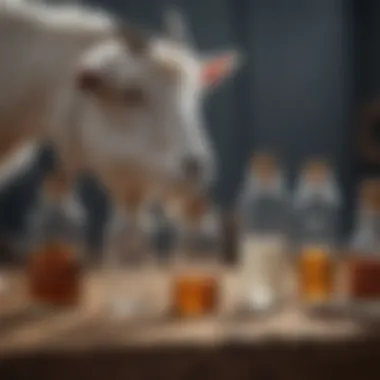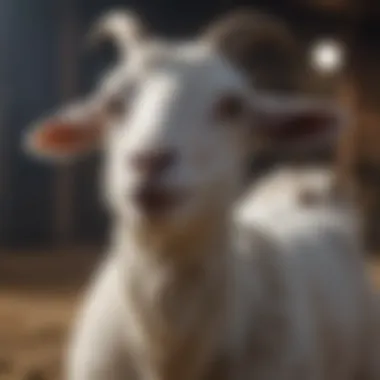Understanding Goat Vaccines: A Comprehensive Guide


Intro
Vaccination in goat husbandry is crucial for maintaining the health and productivity of herds. Vaccines play a significant role in preventing the outbreak of various diseases that can affect goats. As a goat owner, understanding the types of vaccines available, their schedules, and the specific needs of different breeds can help ensure your goats thrive. This guide will provide comprehensive insights into goat vaccines, highlighting key points essential for informed decision-making.
Vaccines and Their Importance
Vaccines are biological preparations that enhance immunity against specific diseases. For goats, several vaccines prevent common infections such as clostridial diseases, respiratory illnesses, and other viral infections. Effective vaccination protects not only individual animals but also contributes to herd immunity, safeguarding the entire flock.
The Role of Herd Immunity
Herd immunity occurs when a significant portion of a population is vaccinated, reducing the spread of disease. In a herd with good immunity, even unvaccinated animals benefit from reduced exposure to pathogens. Understanding the importance of herd immunity can help goat owners prioritize vaccination strategies for optimal outcomes.
Vaccination is not just an individual benefit; it strengthens the entire herd's defense against disease.
Types of Vaccines Available for Goats
Several vaccines are available for goats, and each targets specific diseases. They can be categorized into inactivated (killed) vaccines and modified live vaccines. Inactivated vaccines use killed pathogens, while modified live vaccines contain weakened strains of the disease-causing agent. Each type has its advantages:
- Inactivated Vaccines: Safer for pregnant animals, longer-lasting immunity for some diseases.
- Modified Live Vaccines: Often more effective and prompt immunity responses but may pose a risk for certain populations.
It is vital to consult with a veterinarian to determine which vaccines are most suitable for your herd.
Recommended Vaccination Schedule
A comprehensive vaccination schedule typically includes initial vaccinations and booster shots. Most goats require their first vaccinations at a young age, around two to three months. Following this, periodic booster shots are necessary for continued protection. Here is a general outline of a vaccination schedule:
- Kids: Initial vaccines at 2-3 months, with boosters every 6-12 months.
- Adults: Annual boosters based on exposure risks and veterinarian recommendations.
- Pregnant Goats: Vaccines should be administered before kidding to pass immunity to kids via colostrum.
This schedule may vary depending on the specific health concerns in your region or individual circumstances.
Vaccine Handling and Storage
Proper vaccine handling and storage is crucial for maintaining their effectiveness. Vaccines should be kept in a cool environment and away from direct sunlight. Ensure you are familiar with the manufacturer's guidelines on storage temperatures and usage limits to prevent loss of efficacy. Any compromised vaccines should not be administered.
Considerations for Different Goat Breeds
Different goat breeds may have specific health challenges and immunity requirements. For example, dairy breeds like Saanen may be more susceptible to mastitis and require vaccines that address that. In contrast, meat breeds, such as Boer goats, may thrive with a different set of vaccines focusing on growth and meat quality. Consulting a veterinarian knowledgeable about your breed can help tailor the vaccination approach.
Prelims to Goat Vaccines
Goat vaccines play a crucial role in maintaining the health of these animals, which are valuable for both agricultural and personal reasons. Effective vaccination can prevent various diseases that affect goats, fostering a healthier herd and increasing productivity. Understanding goat vaccines involves more than merely administering shots; it requires knowledge of specific diseases, types of vaccines, and the appropriate schedules for vaccination.
Importance of Vaccination
Vaccination is essential because it helps build immunity against diseases that can severely impact goat populations. Goats are susceptible to several infectious diseases, some of which can be fatal. Without vaccination, the risk of disease outbreaks increases, potentially leading to economic loss and compromised animal welfare.
Benefits of vaccination include:
- Reduced incidence of disease
- Increased overall herd health
- Decreased veterinary costs over time
- Improved productivity and reproduction rates
Moreover, vaccination contributes to herd immunity, which lowers the risk of disease transmission within goat herds and to surrounding animals. This collective protection is vital, especially in farming settings where many animals are in close proximity.
Overview of Vaccine Types
Goat vaccines can be categorized into several types, each designed to provide immune protection against specific pathogens. Knowledge of these vaccine types helps goat owners choose the right solution for their herd.
The primary vaccine categories include:
- Killed vaccines: These contain inactivated pathogens, prompting an immune response without causing disease.
- Modified live vaccines: These consist of weakened versions of the virus or bacteria, providing a robust immune response.
- Subunit vaccines: These vaccines contain only parts of the pathogen, such as proteins, which stimulate an immune reaction without exposing the animal to the disease itself.


Each type of vaccine has its own advantages and disadvantages. It is crucial to consult with a veterinarian to determine which type best suits the specific needs of a goat herd based on existing health issues and regional disease prevalence.
Common Diseases in Goats
Understanding common diseases in goats is essential for effective herd management. Awareness of potential health threats enables goat owners to implement timely vaccination and preventive measures. Each disease has specific implications, and knowing them can enhance the overall productivity and longevity of the herds. Evaluating the risks associated with these diseases also supports informed decisions regarding vaccines and management practices.
Clostridial Diseases
Clostridial diseases are a group of serious infections caused by bacteria from the Clostridium species. They can affect goats of all ages, posing significant health risks. Some common clostridial diseases include:
- Clostridium perfringens: Causes enterotoxemia, also known as “overeating disease.” It can lead to sudden death if not addressed swiftly.
- Clostridium tetani: Responsible for tetanus, which results from wounds or injuries contaminated with spores. This disease has a high mortality rate without appropriate treatment.
- Clostridium novyi: Known for causing black disease, primarily in well-nourished, older animals. It can lead to rapid organ failure.
Preventing clostridial infections involves vaccinating goats with a combination vaccine that covers these bacteria. Ensuring that goats are vaccinated according to a recommended schedule is crucial for minimizing risks associated with these life-threatening diseases.
Respiratory Diseases
Respiratory diseases in goats can stem from various pathogens and environmental conditions. Healthy respiratory function is vital for goat well-being, as respiratory ailments can lead to chronic health problems. Common respiratory diseases include:
- Pneumonia: Often caused by bacterial infections, pneumonia can develop in young, stressed, or immunocompromised goats. The same can happen when goats are kept in overcrowded or unhygienic conditions.
- Pasteurellosis: Caused by Pasteurella multocida and often linked to stress or viral infections. Early intervention with appropriate antibiotics can save affected animals.
- Chronic respiratory disease: Characterized by persistent coughing and discharge, it requires long-term management strategies.
Vaccination against respiratory diseases plays a pivotal role in managing goat health. Consulting a veterinarian regarding the appropriate vaccines for different age groups and risk factors is important for maintaining herd health.
Contagious Caprine Pleuropneumonia
Contagious caprine pleuropneumonia is a serious infectious disease caused by Mycoplasma capricolum. It primarily affects goats and can lead to severe respiratory issues. The disease manifests with symptoms including:
- Fever: Elevated body temperature is often one of the initial signs.
- Coughing and nasal discharge: These symptoms are indicative of respiratory distress.
- Loss of appetite and weight: Infected goats may exhibit reduced feed intake, leading to significant weight loss.
The contagious nature of this disease makes it a concern for herd management. Vaccination is an effective method to control the spread of the disease, especially in areas with a high incidence. It is essential to monitor herd health continuously and work closely with veterinarians to implement a proper vaccination protocol for at-risk populations.
Timely vaccination and proactive management can drastically reduce the incidence of these common diseases in goats.
Types of Vaccines for Goats
Vaccination plays a critical role in maintaining goat health. Understanding the different types of vaccines available helps goat owners make informed decisions. Choosing the right vaccine can greatly reduce the risk of disease and improve herd immunity. Each type has its benefits and specific considerations that owners should be aware of.
Killed Vaccines
Killed vaccines, also known as inactivated vaccines, contain pathogens that have been killed or destroyed. This type ensures that the immune system creates a response without the risk of causing the disease. They are typically stable and less likely to cause side effects.
Benefits
- Safety: They cannot revert to a virulent form.
- Stability: Killed vaccines have a longer shelf life.
- Simplicity: They are easy to administer.
Considerations
However, killed vaccines generally require multiple doses to achieve full effectiveness. They may also induce a weaker immune response compared to live vaccines, necessitating booster shots. Goat owners should be aware of the approved killed vaccines, such as Bar-Vac CD/T, which protects against clostridial diseases.
Modified Live Vaccines
Modified live vaccines are created from live pathogens that have been attenuated, or weakened. These vaccines induce a strong immune response and typically require fewer doses than killed vaccines.
Benefits
- Strong Immune Response: They often provide longer-lasting immunity.
- Fewer Doses Needed: Usually just one or two doses are necessary.
Considerations
There is a risk of the vaccine reverting to a virulent form, which makes it crucial to follow guidelines on storage and administration. Modified live vaccines, like the Cattlevac® vaccine, are useful against diseases like infectious bovine rhinotracheitis. It’s important for goat owners to consult their veterinarians for recommendations on using modified live vaccines, especially for pregnant goats, as they may not be suitable in all cases.


Subunit Vaccines
Subunit vaccines consist of only parts of the pathogen, usually proteins, rather than the whole germ. This approach allows for a targeted immune response.
Benefits
- Lower Risk of Side Effects: They generally have fewer adverse reactions.
- Specificity: The immune system can respond to the specific parts of the pathogen.
Considerations
However, subunit vaccines may require adjuvants to enhance their effectiveness. They might also necessitate multiple doses for adequate protection. Some examples include the E. coli subunit vaccine used in goats. As with other vaccines, veterinary guidance is crucial in determining the best vaccination strategy.
Vaccination Schedule for Goats
A vaccination schedule is a key element in goat management. It ensures that goats receive timely vaccinations against specific diseases. A well-planned schedule reduces the risk of outbreaks in the herd, promoting overall health. Following vaccination guidelines helps maintain production levels and prevents economic losses in goat farming.
Initial Vaccination Protocol
The initial vaccination protocol usually begins when kids are around three months old. This early stage is vital for establishing immunity against several diseases. Common vaccinations during this phase include those for clostridial diseases and respiratory illnesses. It is critical to consult a veterinarian to determine the best vaccines for your geographic location and specific herd conditions.
Vaccine administration should be documented carefully. Track each goat, noting the date and type of vaccine given. This record is essential for future reference and boosts compliance with regulations. Typically, administering a killed vaccine initially is recommended, following up with a modified live vaccine later.
Booster Shots
Booster shots are necessary to maintain immunity. After the initial vaccinations, goats should receive booster shots at regular intervals. These usually occur annually. The timing might differ based on the vaccine type and specific diseases targeted. Regular boosters are especially important in regions with high disease prevalence.
It's important for farmers to be attentive to vaccination dates. Missed boosters can lead to decreased immunity among the herd, increasing disease susceptibility. A systematic approach to tracking booster shots ensures sustained health and productivity in your goats.
Considerations for Pregnant Goats
Vaccination in pregnant goats requires particular attention. Vaccinations should be scheduled to avoid any adverse reactions during pregnancy. Most doctors recommend vaccinating does before breeding or early in gestation. This strategy protects both the mother and her kids. Certain vaccines can pass immunity through the colostrum, giving newborns a better start.
Consulting a veterinarian for specific vaccine recommendations during pregnancy is crucial. Some vaccines are safer than others during this period. Moreover, timing the administration correctly helps avoid stress for the mother and ensures the best outcomes for her kids.
Always prioritize the health of pregnant goats by adhering to tailored vaccination schedules to safeguard future generations.
Understanding Herd Immunity
Herd immunity plays a critical role in maintaining goat health. This concept refers to the resistance of a population to the spread of infectious diseases when a significant portion of the herd is immune. Immunity can arise from natural infection or through vaccination. Effective vaccination programs can significantly contribute to herd immunity, protecting not only the immunized goats but also those that are unvaccinated or less receptive to vaccines. This collective immunity is essential, particularly in farming environments where the interaction of different animals increases the risk of disease transmission. Understanding herd immunity helps goat owners implement informed vaccination strategies that enhance the overall resilience of their herds.
Concept of Herd Immunity
The concept of herd immunity is simple yet powerful. When a large percentage of a goat population is vaccinated, the spread of contagious disease becomes less likely. This is because the number of animals that can transmit the disease diminishes. The threshold for herd immunity varies depending on the disease, but achieving this status is crucial for controlling outbreaks. For instance, in the case of Clostridial diseases, having a well-vaccinated population contributes to significantly lower infection rates. This can lead to fewer veterinary costs, reduced mortality rates, and better production performance.
Impact on Goat Health
Herd immunity has a direct impact on goat health. Greater immunity across the herd reduces the likelihood of disease outbreaks, thus protecting vulnerable individuals. Some goats, such as pregnant females and young kids, may be more susceptible to diseases. Maintaining herd immunity helps shield these groups from potential risk. Furthermore, the stress on individual animals decreases when diseases are less prevalent. Consequently, goats experience improved well-being and higher productivity.
Efficient vaccination strategies can create a shield of immunity that guards against common diseases.
Vaccine Handling and Administration
Vaccine handling and administration are crucial aspects of goat vaccination programs. Proper techniques in these areas ensure the effectiveness of vaccinations and minimize the risk of complications. When vaccines are not handled correctly, their efficacy can diminish, leading to potential outbreaks of preventable diseases within the herd. Therefore, understanding the best practices for storage and administration is essential for all goat owners.
Storage Requirements
To maintain vaccine potency, careful storage is necessary. Vaccines typically need to be kept within a specific temperature range. Generally, vaccines should be stored in a refrigerator that operates between 2-8 degrees Celsius. Here are some key points to consider:
- Avoid Freezing: Extreme cold can destroy the vaccine's active components. Always check that your refrigeration system does not allow the vaccine to freeze.
- Monitor Temperature: Use a thermometer to keep track of the fridge temperature. Some fridges may have features that alert you when temperatures fluctuate.
- Organize Your Storage: Place vaccines in their original packaging away from food and other medications. This prevents cross-contamination and simplifies inventory management.
- Expiry Dates: Regularly check expiration dates on vaccine vials. Using expired vaccines can lead to ineffective vaccination.
- Use Within Recommended Time: Some vaccines have specific time frames for usage once they are opened. Following those guidelines is critical for maintaining vaccine effectiveness.


Injection Techniques
Administering vaccines correctly is as important as storage. Improper injection can lead to reduced immune response and unnecessary stress for the goats. Here are some techniques to consider:
- Choose the Right Site: The recommended site for injections is usually just under the skin (subcutaneous) and often in the loose skin over the shoulder area. Choose an area that is clean and free from dirt.
- Syringe Selection: Use a syringe that is appropriate for the volume of the vaccine. A 20-gauge needle works well for most vaccines, ensuring a balance between effectiveness and comfort.
- Aseptic Technique: Always use sterile needles and syringes. Clean the injection site with alcohol or antiseptic wipes before administering the vaccine.
- Injection Speed: Inject the vaccine slowly. Quick injections can cause discomfort and stress for the goats.
- Observe for Reactions: After vaccination, monitor goats for any adverse reactions. Most goats will show no side effects, but be prepared to respond to any unexpected issues.
Proper handling and administration of vaccines can significantly enhance the effectiveness of your herd's immunization program. It is essential to familiarize yourself with these techniques to ensure the health and productivity of your goats.
By adhering to proper storage and injection protocols, goat owners can significantly bolster their vaccination efforts. This not only protects individual goats but also contributes to the overall health and productivity of the entire herd.
Specific Considerations for Different Breeds
The approach to vaccination in goats cannot be one-size-fits-all. Different breeds have distinct traits, health concerns, and susceptibility to specific diseases. Understanding these nuances is crucial for effective herd management. Each breed—whether it be meat, dairy, or fiber—will benefit from tailored vaccination strategies that address their specific needs.
Meat Goats
Meat goats, like the Boer breed, often face unique health challenges. These animals are generally bred for growth and meat production. They may be more susceptible to Clostridial diseases due to rapid growth rates and feeding regimes that can sometimes compromise their immune health. Vaccination against Clostridium perfringens types C and D is critical. It helps prevent enterotoxemia, a disease that can cause sudden death in young goats. Additionally, vaccinations for Pasteurella multocida may be recommended, as meat goats can also be at risk for respiratory diseases during transport or stressful conditions. Keeping a consistent vaccination schedule ensures these goats maintain optimal health and reduce mortality.
Dairy Goats
Dairy goats, such as Saanen or Nubian breeds, rely heavily on their health for milk production. These animals are often more susceptible to specific diseases due to their genetic predispositions and life stressors associated with high milk yield. Vaccination programs for dairy goats should consider diseases like Caprine Arthritis Encephalitis (CAE) and Contagious Agalactia. Immunization against these diseases can greatly impact overall productivity, as CAE can severely affect a goat's ability to produce milk. Furthermore, the standards of milk quality regulations highlight the need for disease control through effective vaccination. A tailored vaccination schedule can mitigate potential health issues and sustain herd productivity.
Fiber Goats
Fiber goats, primarily Angora or Cashmere breeds, serve a different purpose, focusing on fiber production. Their diseases can vary slightly from those of meat and dairy goats. Fiber goats are often at risk for foot rot and keratoconjunctivitis due to their living conditions. While there are no specific vaccines for these conditions, preventive measures should be taken to avoid outbreaks. A vaccination program for these breeds often includes vaccinations against Clostridial diseases and tetani, especially since they can suffer from mineral deficiencies that impact their immune systems. Ensuring they are well-vaccinated can lead to better fleece quality and quantity, making the investment in vaccines worthwhile.
In summary, understanding the specific considerations for different breeds is essential for effective goat husbandry. By identifying the unique health needs and potential disease risks associated with meat, dairy, and fiber goats, owners can implement more effective vaccination strategies. This will not only promote better health but will also enhance productivity across the herd.
Challenges in Vaccination
Vaccination in goats is crucial for maintaining herd health, yet several challenges can hinder the successful implementation of vaccination programs. Awareness of these challenges allows goat owners to better devise strategies to combat them and ensure the well-being of their livestock. Addressing issues such as vaccine resistance and geographical variations in disease prevalence can significantly impact herd immunity and overall health outcomes.
Vaccine Resistance
Vaccine resistance is a growing concern in veterinary medicine. It occurs when pathogens change or evolve in ways that make vaccines less effective. This can result from selective pressure exerted by widespread vaccination. As a result, pathogens that survive vaccination may develop traits that help them evade the immune response. Such can lead to increased outbreaks and challenges in managing goat herds.
Several factors contribute to vaccine resistance. Genetic diversity among pathogens can allow some strains to persist even in vaccinated populations. Moreover, inappropriate vaccination protocols, including missed booster shots, can stress the immune system, facilitating the emergence of resistant strains.
To mitigate vaccine resistance, it is essential to:
- Develop and adapt vaccination strategies based on local epidemiology.
- Monitor the effectiveness of vaccines regularly.
- Ensure proper vaccination techniques to maximize the immune response.
- Encourage herd immunity by vaccinating all animals within a herd effectively.
Engaging with veterinarians and maintaining an effective disease management plan can help in tackling these challenges and reducing the impact of vaccine resistance.
Geographical Variations in Disease Prevalence
Geographical differences play a significant role in the effectiveness of vaccination programs. Diseases that affect goats can vary considerably across regions due to several factors, including climate, environment, and farming practices. For instance, a disease prevalent in one area may be virtually absent in another, thus affecting the risk assessment and decisions related to vaccination.
Farmers must understand the specific diseases that pose the highest risk in their geographical locations. This allows for targeted vaccination programs that address local needs. For example, regions with higher incidences of respiratory diseases may require prioritization of vaccines to combat these issues. By customizing their approach to vaccination based on regional disease prevalence, goat owners can optimize the health of their herds.
To effectively manage geographical variations, consider the following:
- Regularly review local disease reports and trends.
- Consult with local veterinarians to identify regional threats.
- Adjust vaccination schedules and types according to shifting disease patterns over time.
Understanding the specific disease landscape is essential for designing effective vaccination strategies and improving herd health outcomes.
Finale
Vaccination in goats carries significant weight within the context of overall herd health. This article has delved into various facets of goat vaccination, emphasizing its critical role in disease prevention and management. The intrinsic connection between effective vaccination strategies and the health of individual goats and the herd as a whole cannot be overstated.
Final Thoughts on Vaccination
Vaccination serves as the cornerstone of preventive health care for goats. Employing a well-structured vaccination schedule can drastically reduce the incidence of several dangerous diseases, ensuring that goats live healthy and productive lives.
- Understanding Disease Prevention: Knowledge of the diseases prevalent in goats and how vaccines counteract them is essential for informed decision-making.
- Breed Specific Considerations: Different breeds may have unique vaccination needs. Adjusting protocols to cater to these variances enhances overall effectiveness.
- Herd Immunity: This concept underscores the collective protection offered by vaccination, highlighting its broader significance. An increased number of vaccinated individuals elevates protection even for those who cannot be vaccinated due to health constraints.
- Regular Review of Protocols: As research evolves, revisiting vaccination practices ensures alignment with the latest veterinary recommendations and disease developments.
Adopting a proactive approach to vaccination can make a notable difference in the wellbeing of goats. Maintaining vigilance about vaccination schedules, understanding specific needs of the herd, and staying informed about new vaccine innovations ultimately fosters a healthy goat population.







